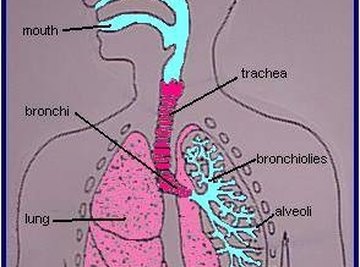
Animals Need Oxygen and Need to Get of Carbon Dioxide
Breathing is important to organisms because cells require oxygen to move, reproduce and function. Breath also expels carbon dioxide, which is a by-product of cellular processes within the bodies of animals. If carbon dioxide built up in a body, death would result. This condition is called carbon dioxide poisoning.
How People and Animals Breathe
A human breathes about 20 times per minute, taking in 13 pints of air during that time. Breathing brings air (oxygen, nitrogen and traces of carbon dioxide) into the blood, which circulates it throughout the body. Most animals breathe in through one type of nose or another. Air then passes through the larynx and trachea, where it is directed to the chest cavity. Other animals have more or less similar organs or a simplified system to do the same thing. In the chest, the trachea splits into two bronchi, which lead to the lungs. Within the lungs are small sacs called alveoli. Oxygen passes into the alveoli and diffuses through capillaries into the bloodstream. Red blood cells take needed oxygen to all parts of the body. At the same time, blood from the veins, rich in carbon dioxide, releases the carbon dioxide into the alveoli, which is discharged out of the body by this system going in the opposite direction.
The Diaphragm: The Power Source
The diaphragm is a sheet of muscles across the bottom of the chest. Its task is to contract, which pulls oxygen into the lungs, and relax, which pushes carbon dioxide out of the lungs. At contraction, the diaphragm lowers a body’s internal air pressure and creates space for the lungs to expand. When the diaphragm relaxes, the lungs collapse and carbon dioxide is expelled.
Plants Too
In a way, one can say that plants breathe as well. Grass, trees, flowers and shrubs all take the carbon dioxide from humans and animals, absorb it into their system through leaves and stems, and then use it for cellular energy. The waste by-product of a plant’s “breathing” is oxygen, which is used again by animals.
References
About the Author
Daryn Edelman, a professional writer/lecturer in spirituality, mysticism, business ethics, culture and politics since 1999. He has written scripts for "The Chabad Telethon" and diverse articles featured in "Farbregen Magazine" and Chabad.com. He graduated from the University of California Los Angeles with a Bachelor of Arts in religious studies and the University of Liverpool with a Master of Arts in English.
Photo Credits
http://warriors.warren.k12.il.us/dburke/respiratorysystem.htm
